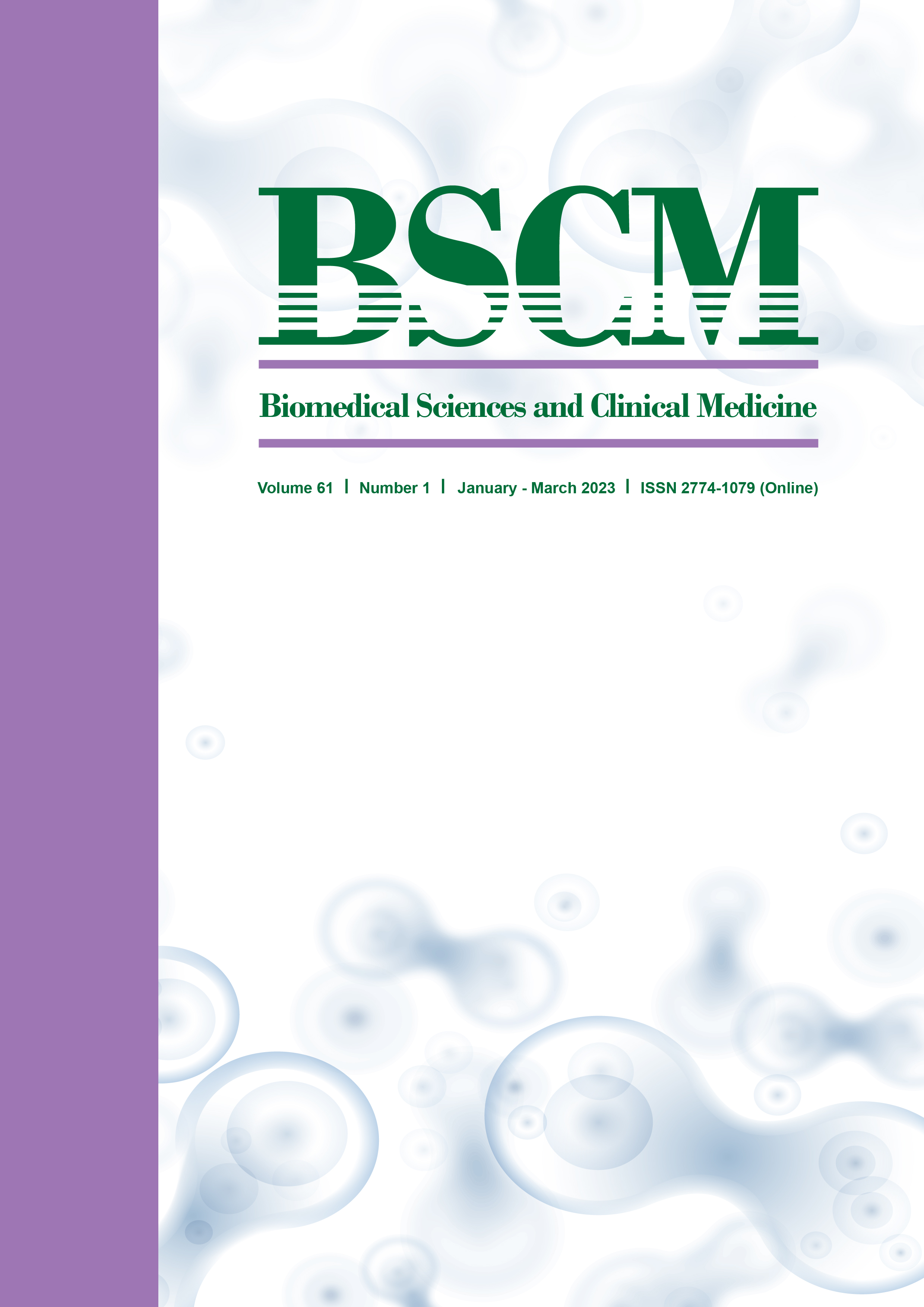Factors Associated with Distant Metastasis from Cutaneous Melanoma: A Study at Maharaj Nakorn Chiang Mai Hospital
Main Article Content
Abstract
OBJECTIVE Cutaneous melanoma is an aggressive tumor associated with high mortality, particularly in the advanced stages. The objective of this study is to identify risk factors for distant metastasis in melanoma patients.
METHODS This retrospective analytical study included all patients diagnosed with cutaneous melanoma and treated at Maharaj Nakorn Chiang Mai Hospital between January 2002 and July 2019.
RESULTS One hundred and forty patients were enrolled in the study. Distant metastasis was found in 45% of the patients (n = 63) and the most common site was the lung (27.9%, n = 39). Multivariable analysis detected two significant prognostic factors for distant metastasis: Breslow thickness 2-4 mm and > 4 mm (p = 0.048 and 0.045, respectively) and nodal metastasis (p < 0.0001).
CONCLUSIONS Breslow thickness > 2 mm and nodal metastasis are associated with distant metastasis and the lung is the most common site of distant metastasis. The patients found to be at risk should be aggressively investigated for distant metastasis.
Article Details

This work is licensed under a Creative Commons Attribution 4.0 International License.
References
Ferlay J, Colombet M, Soerjomataram I, Mathers C, Parkin DM, Piñeros M, et al. Estimating the global cancer incidence and mortality in 2018: GLOBOCAN sources and methods. Int J Cancer. 2019;144:1941-53.
MacKie RM, Hauschild A, Eggermont AM. Epide-miology of invasive cutaneous melanoma. Ann Oncol. 2009;20 Suppl 6(Suppl 6):vi1-7.
Cherobin ACFP, Wainstein AJA, Colosimo EA, Gou-lart EMA, Bittencourt FV. Prognostic factors for metastasis in cutaneous melanoma. An Bras Der-matol. 2018;93:19-26.
Jemal A, Siegel R, Ward E, Hao Y, Xu J, Thun MJ. Cancer statistics, 2009. CA Cancer J Clin. 2009;59: 225-49.
Balch CM, Soong SJ, Murad TM, Smith JW, Maddox WA, Durant JR. A multifactorial analysis of mela-noma. IV. Prognostic factors in 200 melanoma patients with distant metastases (stage III). J Clin Oncol. 1983;1:126-34.
Neuman H, Patel A, Hanlon C, Brady M, Halpern A, Houghton A, et al. A single-institution validation of the AJCC staging system for stage IV melanoma.Ann Surg Oncol. 2007;25(18_suppl):8517.
Gershenwald JE, Scolyer RA, Hess KR, Sondak VK, Long GV, Ross MI, et al. Melanoma staging: Evi-dence based changes in the American Joint Com-mittee on Cancer eighth edition cancer staging manual. Cancer J Clin. 2017;67:472-92.
Filippi AR, Fava P, Badellino S, Astrua C, Ricardi U, Quaglino P. Radiotherapy and immune check-points inhibitors for advanced melanoma. Radio-ther Oncol. 2016;120:1-12
Vatanasapt V, Martin N, Sriplung H, Chindavijak K, Sontipong S, Sriamporn H, et al. Cancer inci-dence in Thailand, 1988-1991. Cancer Epidemiol Biomarkers Prev. 1995;4:475-83.
Breslow A. Thickness, cross-sectional areas and depth of invasion in the prognosis of cutaneous melanoma. Ann Surg. 1970;172:902-8.
Balch CM, Murad TM, Soong SJ, Ingalls AL, Halpern NB, Maddox WA. A multifactorial anal-ysis of melanoma: prognostic histopathological features comparing Clark’s and Breslow’s staging methods. Ann Surg. 1978;188:732-42.
Brauer JA, Wriston CC, Troxel AB, Elenitsas R, Shin DB, Guerry D, et al. Characteristics associated with early and late melanoma metastases. Cancer. 2010;116:415-23.
Pollack LA, Li J, Berkowitz Z, Weir HK, Wu XC, Ajani UA, et al. Melanoma survival in the United States, 1992 to 2005. J Am Acad Dermatol. 2011;65(5 Suppl 1):S78-86
de Vries E, Nijsten TE, Visser O, Bastiaannet E, van Hattem S, Janssen-Heijnen ML, et al. Superi-or survival of females among 10 538 Dutch mel-anoma patients is independent of Breslow thick-ness, histologic type and tumor site. Ann Oncol. 2008;19:583-9.
Mervic L. Time course and pattern of metastasis of cutaneous melanoma differ between men and women. PLoS One. 2012;7:e32955.
Denat L, Kadekaro AL, Marrot L, Leachman SA, Abdel-Malek ZA. Melanocytes as instigators and victims of oxidative stress. J Invest Dermatol. 2014; 134:1512-18.
Conley J, Lattes R, Orr W, Surgery R. Desmoplastic malignant melanoma (a rare variant of spindle cell melanoma). Cancer. 1971;28:914-36.
Rutkowski P, Nowecki ZI, Zdzienicki M, Michej W, Symonides M, Rosinska M, et al. Cutaneous mela-noma with nodal metastases in elderly people. Int J Dermatol. 2010;49:907-13.
Balch CM, Wilkerson JA, Murad TM, Soong SJ, In-galls AL, Maddox WA. The prognostic significance of ulceration of cutaneous melanoma. Cancer. 1980; 45:3012-7.
Ny L, Hernberg M, Nyakas M, Koivunen J, Odder-shede L, Yoon M, et al. BRAF mutational status as a prognostic marker for survival in malignant mel-anoma: a systematic review and meta-analysis. Acta Oncol. 2020;59:833-44.
Libra M, Malaponte G, Navolanic PM, Gangemi P, Bevelacqua V, Proietti L, et al. Analysis of BRAFmutation in primary and metastatic melanoma. Cell Cycle. 2005;4:1382-4.


